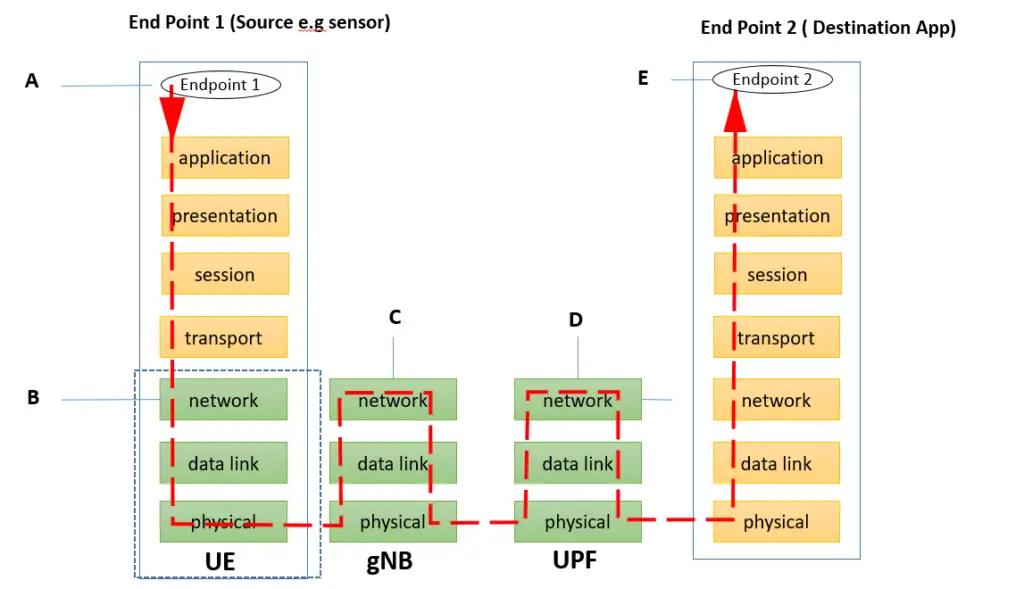So you want to know about 5G latency?
And you know that the minimum latency needed for 5G is 1 ms or less.
What if I tell you that you may be completely misunderstanding how this latency works in “5G”
For example, tell me the following.
- Is the latency from the cellphone to the core?
- Is it from the base station to the application?
- Is it a round trip or one way?
Let me tell you, I do see a lot of confusion here. I do find a lot of well-meaning people make an unintentional “mistake”.
For example, it is very common to use “round trip delay” for all latencies when in fact it is a “one-way delay”.
If you start with the wrong reference, you end up with the wrong answers. An application hosted in a data center placed with the understanding of round trip time “RTT” will have a different distance from the reference point than one placed with a one-way delay.
Wrong placement of data center is a wrong CAPEX investment. Above all, it can result in a bad customer experience for the low latency service.
Understand the “Latency Reference” before the “Latency”
Do you know that knowledge about 5G latency is important but a more important thing is how the latency is defined itself? or the “Latency Reference”
I will help you clarify the concept with this blog piece and I will use the main industry references i.e. NGMN and 3GPP.
More specifically
This blog piece will clarify the following points
- Exact reference for latency measurements to clarify the confusion.
- Latency values for different uRLLC use cases in 5G
Also perhaps you want to establish Edge Cloud or MEC so you are interested in knowing the correct 5G latency reference and values
Why it is important to discuss 5G latency in the first place?
As the 5G moves to an era of new services like low latency uRLLC, latency becomes a critical factor in dimensioning the cellular network. This is also important when designing a cellular network for network slicing.
Life was quite easier with the initial 5G services like “eMBB” that require faster speed, however, It is no longer the case for latency-prone uRLLC services.
A common perception is that the most important benefit 5G brings is higher data speed. However, 5G is designed to support other services that do not necessarily need high speed but need low latency.
What are these 5G terms?
eMBB vs eMTC vs uRLLC
eMBB: Enhanced Mobile Broadband-High data rate and high traffic volume- This is the first use case for 5G that supports high bandwidth broadband/download speed.
mMTC : Massive Machine-Type Communication: Massive number of low cost, low energy devices. A common example is a massive number of IoT devices in a small geographical area. It is characterized by low bandwidth but high density per given area/high connection density.
uRLLC-Ultra-Reliable Low-Latency Communication: This is characterized by very low latency communication. ( some less than 1 msec). Some examples are Self-Driving car, Robots Control, factory automation, Remote Surgery, virtual reality, etc
Clarifying “Latency Reference”. Is it One Way or Round Trip
We will use NGMN and 3GPP as reference for our discussion.
Let’s start with the NGMN reference as 3GPP is using NGMN for latency references.
Consider a simplified network stack shown for typical network architecture.
A source system with seven OSI layers and a destination system with the seven OSI layers. The mobile network includes RAN ( Radio access network) the core network and the application server.

The source talks to the destination, for example, “End Point 1” ( like a sensor or it can be an application on the cell phone) talks to the End Point 2, which is the Destination App. This is the location that hosts the server where Destination App resides.
So according to this paper from NGMN, “End to End latency” is defined as follows:
“End-to-end latency is defined as the time that takes to transfer a given piece of information from a source endpoint device to a destination endpoint device, measured at the application service access points, from the moment it is transmitted by the source endpoint device to the moment it is successfully received at the destination endpoint device”
Terms :
UE: User Equipment-An equipment that allows a user access to the network services. For example a cell phone
gNodeB: This is the base station in 5G and part of the Radio Access Network. Alternatively, it can be a base station (eNode B) in 4G in this architecture.( in layman terms it is the cell tower)
UPF: User Plane Function: UPF is an important component of 5G core network. Think of it a gateway through which packet flows to the applications and contribute to user plane latency. An application’s example is youtube or Facebook etc.
So, when the NGMN or 3GPP uses the word E2E ( End to End) latency, it is the one-way latency. In this diagram it is the latency from Point A to point E. However normally people assume that is the End to End latency. In contrast, E2E latency is from A to E and the reverse, which is E to A.
But there are other latencies too as shown is the table below. But whenever the standard bodies are referring to the latencies, it is from the source to the end point which includes the application

Now lets look at another reference. This one is from 3GPP. This one also shows End to End latency and its thresholds.
5G Latency Requirements ( Latency thresholds in 5G from 3GPP)
So now lets take an example of latencies from standard bodies. We will refer to the 3GPP TS 22.261, Service Requirments for the 5G. All these latencies are one way. In fact, 3GPP is using NGMN as a reference for these latencies.

This standard defines the End to End latency as following
“End-to-end latency: the time that takes to transfer a given piece of information from a source to a destination, measured at the communication interface, from the moment it is transmitted by the source to the moment it is successfully received at the destination”
So lets clarify some of the FAQs
Conclusion: End to End latency is one way and NOT a round trip?
Usually, NGMN and 3GPP specify End to End (E2E) latency which is “one way”. However in In few cases, it will mention round trip latency but it will clearly specify “round trip”. Here is the definition of end-to-end from 3GPP TS 22.261
end-to-end latency: the time that takes to transfer a given piece of information from a source to a destination, measured at the communication interface, from the moment it is transmitted by the source to the moment it is successfully received at the destination
Why it matters to know that it is a one-way or round trip?
The whole science of placing the application closer to the user is dependent on the latency budget, a wrong decision can lead to the wrong placement of the Data center. Wrong placement will lead to impact the uRLLC services designed for low latency applications.
Is 1ms ( millisecond) the minimum latency requirement for 5G?
As opposed to popular belief, 1 ms latency is not required for all services. Some services have relaxed latency requirements. The figures above take from 3GPP TS 22.261 show only 1 service that requires less than 1 ms latency i.e. Real-time control for discrete automation. This includes use cases such as motion control of robots, machine tools, factory automation etc
How is this latency different than the Fronthaul latency?
Fronthaul latency is a different latency than the E2E latency budget. The fronthaul latency helps in deciding where to place the DU/BBU rather than application itself
So that’s it about the latency. It is important to know the limits when you are designing the network for low latency applications , be it Smart Grid, Autonomous Driving, factory automation, self-driving car etc. This will severely affect the quality of service if the network is not properly designed for the required latency. Also it will also mean that the network slicing is not properly dimensioned for latency.

Hi Faisal,
Nice post, thanks. Very informative.
Helena
Hi Faisal.
Great post and very informative.
Can you do a post on comparing 3G, 4G and 5G architecture? I reckon a lot of your readers will find it useful and informative.
Thanks again for your great work.
Greate Suggestion Shan
Excellent discussion – great post as always Faisal, keep up the great work!!
Thanks Hadi . Happy that you liked it
Thanks Faisal for the informative post. What do you think of mid-haul and back-haul role in end-to-end latency? Perhaps, it should also be mentioned in the picture?
Thanks Anand Ji, the end to end latency includes everything including the FH , MH and BH latency…..but perhaps I should write a dedicated article on xHaul
This is an amazing article. Thank you for sharing.
Am I right to assume that any service operator can charge depending on the latency direction? in this case E2E(oneway) and a separate price for E2E roundtrip?
Im just trying to grasp the example shown above (1st column e.g automotive)
Use Case
E2E remote vehicle operation = 10-30 ms End to End.
why would a use case like remote vehicle require only 1-way latency? and not roundtrip considering this involves control coming from the application/source/operator?
thanks.
Hello, Thank you so much for your comments. The End to End gives you the values. It does not mean that every use case needs end to end one way latency. For the applications that the need round trip, you can just double the latency. The end to end latency is just a way to standardize the definition of not latency; so when you and me talk about latency, we know what are talking objectively.
This is a good article clarify the e2e latency perspective meaning from 5G pov.
Hey Yogendra, thank you for visiting